Writers@Work: An Interview with Author Brenna Jordan
April 23, 2019
Note From Rochelle
Dear Writers,
The Writing Goddesses group wrapped up its spring session last week. We all agreed: we’d accomplished more with less angst because we were working together. We do better when we have people in our lives who are interested in our work and care about our process and progress. If you’re interested in being notified about the next Writing Goddesses session, email me.
Today I’m delighted to welcome author and calligrapher Brenna Jordan to the blog. She has an amazing story. Enjoy!
Enjoy!
Rochelle
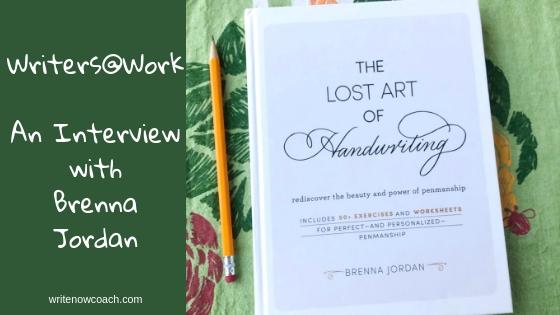
Writers@Work: An Interview with Author Brenna Jordan
by Rochelle Melander
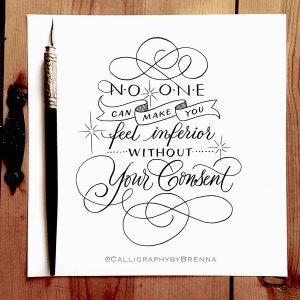 When I heard about Brenna Jordan’s publishing story, I knew I needed to interview her for my newsletter and blog. Her story gives me hope that those of us who work hard at our craft will get published. Enjoy reading about Brenna’s work as a calligrapher and author and be sure to visit her Instagram feed to check out her amazing lettering art.
When I heard about Brenna Jordan’s publishing story, I knew I needed to interview her for my newsletter and blog. Her story gives me hope that those of us who work hard at our craft will get published. Enjoy reading about Brenna’s work as a calligrapher and author and be sure to visit her Instagram feed to check out her amazing lettering art.
Tell us about you. How did you become a professional calligrapher?
I love writing. I love the swirl and swing of words as they tangle with human emotions.
–James Michener
I’ve always loved words, quotes, and beautiful writing, so when I received a calligraphy kit for Christmas in middle school, I was instantly hooked!
One year in English class I did a demonstration speech on calligraphy, using the chalkboard. My teacher was also the football coach, and hired me to fill in the certificates for his team. Word spread and I got a lot of practice doing calligraphy for teachers and coaches in high school.
I didn’t study art in college, but enjoyed doing calligraphy for events on campus, weddings for family and friends, and occasional commissioned projects. This continued when I later married, worked other jobs, and had three children.
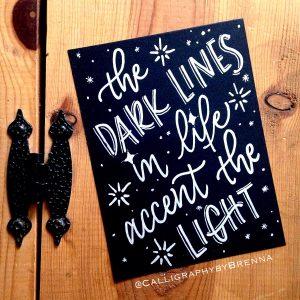 Starting a calligraphy business wasn’t on my agenda until a serendipitous series of events. In 2014, our kids were older, and we moved from our rural home into town to be closer to the myriad activities of a busy household. Around this time, a local bride contacted me to be her wedding calligrapher. I had so much fun that I was sad when I finished the last piece!
Starting a calligraphy business wasn’t on my agenda until a serendipitous series of events. In 2014, our kids were older, and we moved from our rural home into town to be closer to the myriad activities of a busy household. Around this time, a local bride contacted me to be her wedding calligrapher. I had so much fun that I was sad when I finished the last piece!
When the bride mentioned, “It was so hard to find you; you should think about becoming more visible,” her words stuck in my mind. I reached out to a business consultant who encouraged me to take the leap and helped navigate my business launch.
Much of my growth as a calligrapher is due to the Colleagues of Calligraphy and IAMPETH (International Association of Master Penmen, Engrossers, and Teachers of Handwriting). These organizations provide professional instruction from the most proficient calligraphers in the nation.
One class a few years ago was a three-day workshop with Pat Blair, who was the chief calligrapher at the White House for many years. An expert in the traditional Copperplate hand, she helped us fine-tune the techniques of pointed pen to create elegant script. Much of the modern calligraphy popular today is an adaptation of this hand.
I attend several workshops and a week-long conference each year, and also appreciate the accessibility of online classes. I’ve discovered that the most invaluable key to serving my clients and keeping my own passion ignited has been to invest in ongoing education.
Tell us about your book, The Lost Art of Handwriting.
Handwriting is the garden of the sciences. -Abu Dulaf
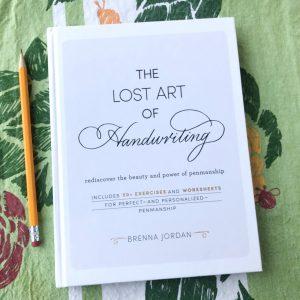 In an age of rapidly-changing technology, the book highlights the unique beauty of handwriting and the advantages of its slower pace. My goal is for readers to get excited about their own style of handwriting, and discover the unexpected treasures that surface while putting words on paper.
In an age of rapidly-changing technology, the book highlights the unique beauty of handwriting and the advantages of its slower pace. My goal is for readers to get excited about their own style of handwriting, and discover the unexpected treasures that surface while putting words on paper.
The Lost Art of Handwriting explores simple alphabets, letter joins, and common problem areas, and progresses to more challenging variations in both cursive and print. It includes exercises for numerals, ampersands, and expressive writing, and introduces calligraphy.
While the 192 pages contain many practice exercises, the content is broader than a typical cursive workbook. Interspersed with compelling facts and stories about notable handwriting heroes, it also delves into the history of handwriting. The wide variety of affirmative quotes throughout the book have personally influenced my life, and hopefully will bring the sense of a friend beside you, encouraging you along on your journey.
Whatever experience a reader may have had with handwriting, this book is meant to be a fresh slate, full of possibility and positivity. Handwriting has power to evoke goodness and delight in the lives of others, and I hope that message shines brightly through all the activities and information in the book.
What tips do you give to people who want to improve their handwriting?
The written letter is something personal, organic, unique, and spontaneous. It mirrors the character and the personality of the writer, and often his mood of the moment.
-Emil Ruder
I think the first step is to cultivate the enjoyment of handwriting. When you encounter a sense of joy and meaning during your practice, you’ll make time for it, which naturally leads to improvement.
We all have different interests, schedules and personalities, so our practice has to be built around what works for us. This might be journaling, taking notes by hand at meetings, writing out favorite song lyrics, or doodling words during TV commercials.
Finding pockets of time for handwriting requires only a little effort and equipment. Keep a notebook and a few favorite writing utensils tucked in your bag to pull out while waiting in a doctor’s office or parking lot.
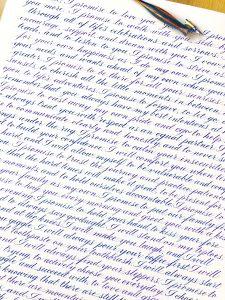 I often practice using school notebooks and pencils. You don’t need anything fancy or expensive, but it is important to feel relaxed with your writing tools. Avoid pens that bleed, smudge or snag on the paper. I used a fountain pen for most of the handwriting examples in the book because of its comfortable design and smooth flow of ink. I recommend trying fountain pens at a store to see what you like before settling on a certain pen.
I often practice using school notebooks and pencils. You don’t need anything fancy or expensive, but it is important to feel relaxed with your writing tools. Avoid pens that bleed, smudge or snag on the paper. I used a fountain pen for most of the handwriting examples in the book because of its comfortable design and smooth flow of ink. I recommend trying fountain pens at a store to see what you like before settling on a certain pen.
Another tip for improving is to identify areas you want to work on, focusing on one at a time. In the book I discuss areas of consistency to develop that will ensure legibility. Having someone else take a look at your writing is helpful for finding troublespots, since many letters look similar and can be easily confused.
One last tip: Be patient with yourself. Improvement takes dedicated effort and there’s always more to learn. It doesn’t take long, however, before you’ll be able to look back and celebrate how far you’ve come!
Can you talk a bit about the path you took to writing and publishing a book? How did it all come about? What was the writing process like?
Don’t bend; don’t water it down; don’t try to make it logical; don’t edit your own soul according to the fashion. Rather, follow your most intense obsessions mercilessly.
-Anne Rice
In early 2018, an acquisitions editor contacted me about writing a book on handwriting when she saw my work on Instagram. After my bio, table of contents and text samples were approved, I signed a contract with Adams Media, a division of Simon & Schuster. All three deadlines were during the summer months! Everything in the world of publishing was new to me, so it was a daunting, yet exhilarating project.
I was thankful for the freedom to write the book in whatever order I chose, so I bounced between researching/writing the text portions, to creating the handwriting samples and practice exercises. I wrote as much as I could during the day, but really loved working at night. Bursts of inspiration often came during those magical hours with everyone asleep and the house quiet.
I didn’t know what to expect when I submitted the manuscript, but the development editor, graphic designers, and copy editors did an amazing job weaving the text and handwriting portions into a clean, attractive layout. The first time paging through the book felt a bit like holding a newborn baby!
You have an impressive Instagram following. Can you share some of your tips for growing and maintaining a large platform on Instagram?
The willingness to show up changes us, It makes us a little braver each time. –Brene Brown
It started with a decision to post daily in 2017. I wasn’t concerned about adding followers to the hundred or so I had, but I wanted to challenge myself, quiet my constant stream of excuses, and show up, even when I struggled with fear and self-doubt. To grow as an artist, I knew I needed to stretch out of comfort zones and create from my heart and imagination, pushing beyond the projects I was doing for customers.
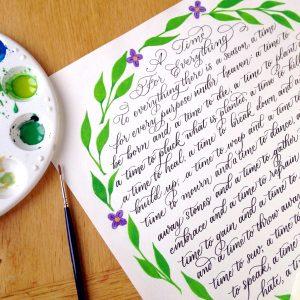
Nearly every day started with prayer, reading from the Bible and stacks of other books, and writing thoughts or quotes for the sheer pleasure of it. This time was a respite from the pressure to perform—a time to pour out my heart, ask God for guidance, and wait for stillness and a sense of being loved, regardless of abilities, accomplishments, or external rewards.
Some days I felt inspired, other days I didn’t create any art that I wanted to share. When I took a break, the old saying, “Get back on the horse,” helped me persist, regardless of fluctuating feelings.
I wanted my art to convey hope, thoughtfulness and warmth, and to bring value to whoever happened to see it. If something had helped me, whether it was a quote, tip, or fun way to flourish, I hoped that it would help someone else, too. Many posts on Instagram evolved from this oasis of unstructured writing, meditation, and prayer.
As my own style emerged, my enthusiasm for lettering increased. More people started following along, often due to curated sites who featured my work on their platforms. This increased visibility opened doors that I didn’t dream possible when I first started.
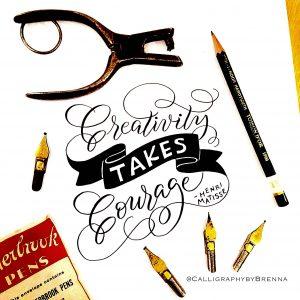 People often ask me how to get more followers. My thought is that growth happens as a byproduct if you consistently show up to serve, strive for excellence in whatever is in your heart to do, and stay true to your distinct personality with all of its gifts. Developing practical skills like taking quality photos and videos, learning tools for editing, and writing captions that connect you with your audience is also helpful.
People often ask me how to get more followers. My thought is that growth happens as a byproduct if you consistently show up to serve, strive for excellence in whatever is in your heart to do, and stay true to your distinct personality with all of its gifts. Developing practical skills like taking quality photos and videos, learning tools for editing, and writing captions that connect you with your audience is also helpful.
Like any tool, social media has benefits and drawbacks. I personally don’t buy into tactics like following/unfollowing, liking and commenting to gain followers, demanding people to look at your feed, and tagging accounts that you want to be noticed by. I think your time is more wisely spent on creative endeavors to better your craft, with the added perk that any social media growth you generate will be more genuine.
While numbers are revealing, it can be tempting to get too fixated on them. Sometimes a piece I really like will get the least amount of engagement. It’s definitely hard work to maintain, but a resolute sense of our purpose and worth keeps us from being tossed around by the whims of other people’s opinions, and also empowers us to be agents of love and kindness in the world.
Finally! I know you listen to a lot of podcasts when you work. Do you listen to books, too? What have been some of your favorite books and podcasts lately?
A word fitly spoken is like apples of gold in settings of silver. -Proverbs 25:11
I go back and forth between audiobooks, podcasts, classical music and talk radio. I listen to Entrepreneurs on Fire, Middays with Susie, The Honest Designers Show, and Faith Play, which has a variety of inspirational speakers. I can never get enough C.S. Lewis, and I also love to pick up new non-fiction titles on education, technology, psychology, health and wellness, parenting, and environmental issues.

About the author: Brenna Jordan lives in Duluth, Minnesota with her husband, Brent, and their three children. When she’s not holding a writing implement, she’s likely to be trail running, hanging out by Lake Superior, or trying to keep enough food in the house for hungry teenagers. Visit her at her website, on Facebook or on Instagram.









I loved reading this interview. I found the questions to be insightful and Brenna’s answers thorough, helpful, and inspiring. Thank you for sharing!